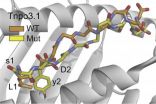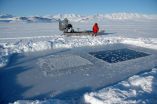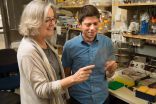(Press-News.org) Greenhouse gas emissions from the production and use of shale gas would be comparable to conventional natural gas, but the controversial energy source actually faired better than renewables on some environmental impacts, according to new research.
The UK holds enough shale gas to supply its entire gas demand for 470 years, promising to solve the country's energy crisis and end its reliance on fossil-fuel imports from unstable markets. But for many, including climate scientists and environmental groups, shale gas exploitation is viewed as environmentally dangerous and would result in the UK reneging on its greenhouse gas reduction obligations under the Climate Change Act.
University of Manchester scientists have now conducted one of the most thorough examinations of the likely environmental impacts of shale gas exploitation in the UK in a bid to inform the debate. Their research has just been published in the leading academic journal Applied Energy and study lead author, Professor Adisa Azapagic, will outline the findings at the Labour Party Conference in Manchester, England, today (Monday, 22 September).
"While exploration is currently ongoing in the UK, commercial extraction of shale gas has not yet begun, yet its potential has stirred controversy over its environmental impacts, its safety and the difficulty of justifying its use to a nation conscious of climate change," said Professor Azapagic.
"There are many unknowns in the debate surrounding shale gas, so we have attempted to address some of these unknowns by estimating its life cycle environmental impacts from 'cradle to grave'. We looked at 11 different impacts from the extraction of shale gas using hydraulic fracturing – known as 'fracking'– as well as from its processing and use to generate electricity."
The researchers compared shale gas to other fossil-fuel alternatives, such as conventional natural gas and coal, as well as low-carbon options, including nuclear, offshore wind and solar power (solar photovoltaics).
The results of the research suggest that the average emissions of greenhouse gases from shale gas over its entire life cycle are about 460 grams of carbon dioxide-equivalent per kilowatt-hour of electricity generated. This, the authors say, is comparable to the emissions from conventional natural gas. For most of the other life-cycle environmental impacts considered by the team, shale gas was also comparable to conventional natural gas.
But the study also found that shale gas was better than offshore wind and solar for four out of 11 impacts: depletion of natural resources, toxicity to humans, as well as the impact on freshwater and marine organisms. Additionally, shale gas was better than solar (but not wind) for ozone layer depletion and eutrophication (the effect of nutrients such as phosphates, on natural ecosystems).
On the other hand, shale gas was worse than coal for three impacts: ozone layer depletion, summer smog and terrestrial eco-toxicity.
Professor Azapagic said: "Some of the impacts of solar power are actually relatively high, so it is not a complete surprise that shale gas is better in a few cases. This is mainly because manufacturing solar panels is very energy and resource-intensive, while their electrical output is quite low in a country like the UK, as we don't have as much sunshine. However, our research shows that the environmental impacts of shale gas can vary widely, depending on the assumptions for various parameters, including the composition and volume of the fracking fluid used, disposal routes for the drilling waste and the amount of shale gas that can be recovered from a well.
"Assuming the worst case conditions, several of the environmental impacts from shale gas could be worse than from any other options considered in the research, including coal. But, under the best-case conditions, shale gas may be preferable to imported liquefied natural gas."
The authors say their results highlight the need for tight regulation of shale gas exploration – weak regulation, they claim, may result in shale gas having higher impacts than coal power, resulting in a failure to meet climate change and sustainability imperatives and undermining the deployment of low-carbon technologies.
Professor Azapagic added: "Whether shale gas is an environmentally sound option depends on the perceived importance of different environmental impacts and the regulatory structure under which shale gas operates.
"From the government policy perspective – focusing mainly on economic growth and energy security – it appears likely that shale gas represents a good option for the UK energy sector, assuming that it can be extracted at reasonable cost.
"However, a wider view must also consider other aspects of widespread use of shale gas, including the impact on climate change, as well as many other environmental considerations addressed in our study. Ultimately, the environmental impacts from shale gas will depend on which options it is displacing and how tight the regulation is."
Study co-author Dr Laurence Stamford, from Manchester's School of Chemical Engineering and Analytical Science, said: "Appropriate regulation should introduce stringent controls on the emissions from shale gas extraction and disposal of drilling waste. It should also discourage extraction from sites where there is little shale gas in order to avoid the high emissions associated with a low-output well.
He continued: "If shale gas is extracted under tight regulations and is reasonably cheap, there is no obvious reason, as yet, why it should not make some contribution to our energy mix. However, regulation should also ensure that investment in sustainable technologies is not reduced at the expense of shale gas."
INFORMATION:
A copy of the paper, 'Life cycle environmental impacts of UK shale gas' by L. Stamford and A. Azapagic, published in Applied Energy (doi 10.1016/j.apenergy.2014.08.063), is available at: http://www.sciencedirect.com/science/article/pii/S0306261914008745.
Fracking's environmental impacts scrutinized
2014-09-22
ELSE PRESS RELEASES FROM THIS DATE:
New rules for anticancer vaccines
2014-09-22
Scientists have found a way to find the proverbial needle in the cancer antigen haystack, according to a report published in The Journal of Experimental Medicine.
As cancer cells divide, they accumulate random mistakes (mutations). This process creates new versions of proteins, some of which are recognized as foreign invaders by immune cells called T cells, prompting the cells to attack and eliminate the cancer cells. With our current ability to identify all of the mutations in a patient's cancer and to understand which protein sequences can be recognized by T cells, ...
Classroom intervention helps shy kids learn
2014-09-22
A program that helps teachers modify their interactions with students based on an individual's temperament helps shy children to become more engaged in their class work, and in turn, improves their math and critical thinking skills.
Led by NYU's Steinhardt School of Culture, Education, and Human Development, the study offers an evidence-based intervention to help shy children, who are often at risk for poor academic achievement. The findings appear in the Journal of School Psychology.
Shy children are described as anxious, fearful, socially withdrawn, and isolated. ...
Arctic sea ice helps remove CO2 from the atmosphere
2014-09-22
Due to global warming, larger and larger areas of sea ice melt in the summer and when sea ice freezes over in the winter it is thinner and more reduced. As the Arctic summers are getting warmer we may see an acceleration of global warming, because reduced sea ice in the Arctic will remove less CO2 from the atmosphere, Danish scientists report.
"If our results are representative, then sea ice plays a greater role than expected, and we should take this into account in future global CO2 budgets", says Dorte Haubjerg Søgaard, PhD Fellow, Nordic Center for Earth Evolution, ...
Nurse survey shows longer working hours impact on quality of care
2014-09-22
Results of a survey of more than 30,000 nurses across Europe show that nurses who work longer shifts and more overtime are more likely to rate the standard of care delivered on their ward as poor, give a negative rating of their hospitals safety and omit necessary patient care.
Led by researchers at the University of Southampton and the National Nursing Research Unit (NNRU) at King's College London, the RN4CAST survey of nurses in over 450 hospitals across 12 European countries, was part of an international research programme looking at links between nursing workforce ...
Singapore researchers discover a gene that increases incidence of AML
2014-09-22
A novel study by the Cancer Science Institute of Singapore (CSI Singapore) at the National University of Singapore (NUS) found that an increase in a gene known as Leo1 affects other genes that are directly implicated in acute myelogenous leukaemia (AML), increasing the incidence of cancer.
Led by Associate Professor Chng Wee Joo, Deputy Director and Senior Principal Investigator at CSI Singapore and Director of the National University Cancer Institute, Singapore, the scientists discovered that inhibition of Leo1 and Leo1 downstream signalling pathways provide an avenue ...
New guidelines issued for managing peri- and postoperative atrial fibrillation
2014-09-22
Beverly, MA, September 22, 2014 – The American Association for Thoracic Surgery (AATS) has released new evidence-based guidelines for the prevention and treatment of perioperative and postoperative atrial fibrillation (POAF) and flutter for thoracic surgical procedures. The guidelines are published in The Journal of Thoracic and Cardiovascular Surgery.
"These guidelines have the potential to prevent the occurrence of atrial fibrillation in thousands of patients who undergo lung surgery in the United States each year. The AATS is committed to its goal of improving the ...
Evidence supports deep brain stimulation for obsessive-compulsive disorder
2014-09-22
September 22, 2014 – Available research evidence supports the use of deep brain stimulation (DBS) for patients with obsessive-compulsive disorder (OCD) who don't respond to other treatments, concludes a review in the October issue of Neurosurgery, official journal of the Congress of Neurological Surgeons (CNS). The journal is published by Lippincott Williams & Wilkins, a part of Wolters Kluwer Health.
Based on evidence, two specific bilateral DBS techniques are recommended for treatment of carefully selected patients with OCD, according to a new clinical practice guideline ...
Involving female offenders in release planning can increase reintegration success
2014-09-22
TORONTO, Sept, 22, 2014--Women who are about to be released from prison need to be more involved in their discharge planning if they are to successfully reintegrate into their communities and avoid returning to prison, according to a new study.
Almost half of all female prisoners are back behind bars within one year of their release and most have multiple prison terms, mainly for drug-related offenses.
Dr. Flora Matheson, a researcher at St. Michael's Hospital, conducted one-on-one interviews with women who were about to be released or had been recently released from ...
Scientists discover an on-off switch for aging cells
2014-09-22
La Jolla -- Scientists at the Salk Institute have discovered an on-and-off "switch" in cells that may hold the key to healthy aging. This switch points to a way to encourage healthy cells to keep dividing and generating, for example, new lung or liver tissue, even in old age.
In our bodies, newly divided cells constantly replenish lungs, skin, liver and other organs. However, most human cells cannot divide indefinitely–with each division, a cellular timekeeper at the ends of chromosomes shortens. When this timekeeper, called a telomere, becomes too short, cells can no ...
Where is that spacecraft?
2014-09-22
Philadelphia, PA—Space surveillance is inherently challenging when compared to other tracking environments due to various reasons, not least of which is the long time gap between surveillance updates. "Unlike the air and missile defense environments where objects are frequently observed, the space surveillance environment data is starved, with many objects going several orbital periods between observations," according to researcher Joshua Horwood. "Thus, it is more challenging to predict the future location of these sparsely-seen objects and they have a tendency to get ...



